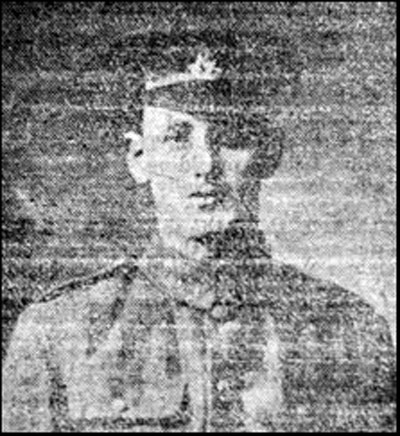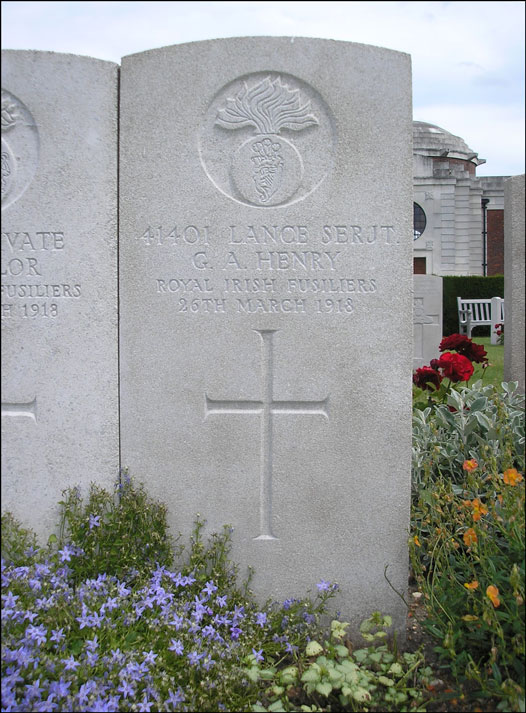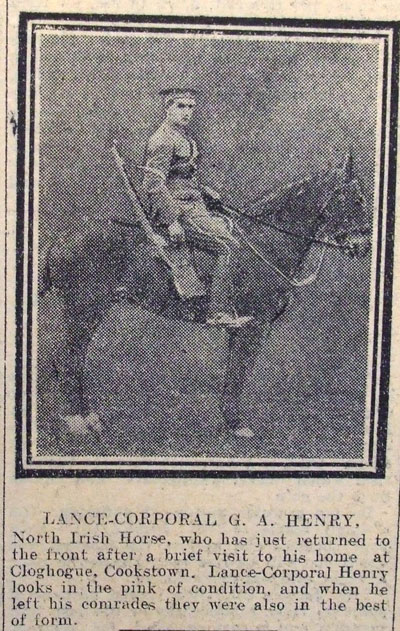![]() In memoriam
In memoriam ![]()
Lance Sergeant George Adams Henry, MM


George Adams Henry was born on 23 May 1894 at Cloghog, Cookstown, County Londonderry, the youngest of six children of farmer William James Henry and his wife Jane (nee Irvine).
Henry enlisted in the North Irish Horse at Cookstown between 23 February and 19 March 1912 (No.683). He embarked for France with C Squadron on 20 August 1914, seeing action in the retreat from Mons and advance to the Aisne.
On 28 November 1914 the Mid-Ulster Mail reported that:
Driver W. J. Arbuthnott, of the North Irish Horse, son of Mr. W. J. Arbuthnott, Drumbonaway, writing to a friend says:--"... I have come through a few battles safely. All the rest of the boys are well and doing good work at the front, especially the Cookstown chaps. We are very well looked after with food and clothes, and we never want for anything, and not one of the Cookstown party of the North Irish Horse has got a wound, though all have shown up bravely at the post of duty. Sergeant Ashcroft, John Maxwell, Samuel Espey, Willie Crooks, Willie Anderson, George Henry, and Albert James McKenna, are the Cookstown fellows in the same troop as me.
Henry was also mentioned in a letter published in the Mid-Ulster Mail on 12 December 1914:
Trooper Robert Averall, of the North Irish Horse, writing to Mr. John G. Gamble, of Magherafelt, in 2nd inst., says – "We are having a badly needed rest just now, as our horses were nearly played out. Cavalry is not much use in the trenches, but we hope to get plenty of work when the Germans get on the move again, and I hope the next halt will be in Berlin. It is hardly likely we will be home for Christmas, but I hope we will be there for the 'Twelfth!' Four Cookstown fellows are here in my troop – Sergeant Ashcroft, Corporal Espie, Lance-Corporal Henry, and Trooper Willie Crooks. We are visited by the enemy's aeroplanes almost every day. They fly over our lines and drop bombs all over the place but do not do much damage, and we usually manage to bring them down in the end. We were on guard during the King's visit, and were on the look out for spies. We succeeded in capturing two disguised as shepherds. They had some sheep and a dog. We are getting tired of mutton chops, so we will perhaps try dog-flesh for a change!! Remember me to all the comrades in the U.V.F., and tell them I am hoping to rejoin their ranks soon.
At the end of 1915 Henry returned home on leave, a report of which appeared in the local newspaper. Inaccuracies in the report suggesting that Henry's squadron was not often in the firing line led three men of C Squadron to write to the paper seeking a correction:
Dear Sir, – We would respectfully draw your attention to a statement which appeared in a recent issue of your paper, just come to hand, namely, that Troopers S. Espie and G. Henry were home on leave from the Squadron of North Irish Horse (A) acting as bodyguard to Sir John French at General Headquarters.
The above-mentioned are corporals and belong to C Squadron, which as been acting as Divisional Cavalry since coming to France on August 22nd, 1914, with the exception of a few months last winter, when the squadron was broke up to work with different Corps Headquarters. Owing to absence of real cavalry work, the chief work of the Squadron has been in the nature of pioneer work, viz., trench digging, barb-wiring, and sand-bagging redoubts, etc., and on several occasions the wiring has been done outside the front line parapets, not fifty yards from the German trenches; also carrying wounded from trenches to advanced dressing stations; escorting German prisoners to nearest rail-head from reserve line, and taking their turn in the trenches as infantry when required. In fact this Squadron has not been out of the firing line (proper) since they came out, and a good many of our comrades out here have rather resented the statement, that has so often erroneously appeared in your valuable paper, that the Squadron was on Headquarters work.
Esteeming the favour of a correction at an early date, with best wishes to the good old Mail for the New Year. We remain
Yours faithfully,
R. Averall, 485; H. Bradley, 978; Corporal S. Brown, 583.
No. 1 Troop, C Squadron, N.I.H.,
3rd Division Cavalry, B.E.F.
1st January, 1916.(Mid-Ulster Mail, 15 January 1916)
In August 1917 the 2nd North Irish Horse Regiment, of which C Squadron was a part, was dismounted and most of its officers and men transferred to the infantry. After a few weeks training, on 20 September most were posted to the 9th (Service) Battalion, Royal Irish Fusiliers, subsequently named the 9th (North Irish Horse) Battalion. Henry was issued a new number – 41401 – and posted to C Company.
Henry saw action with his battalion in the Battle of Cambrai in November and December 1917. On 16 December he took part in a successful raid on an enemy outpost south of Marcoing, led by Lieutenant G.W. Vesey. Vesey was later awarded a Military Cross for his part in the raid, while Henry and one other were awarded Military Medals.
On the evening of 14 March 1918 as the battalion moved into reserve trenches at Grand Seraucourt, Henry was severely wounded. Evacuated to the Australian General Hospital at Rouen, he died twelve days later.
Henry was buried at St. Sever Cemetery Extension, Rouen, Seine-Maritime, France, grave P.VI.H.12B. His gravestone inscription reads:
41401 LANCE SERJT.
G. A. HENRY
ROYAL IRISH FUSILIERS
26TH MARCH 1918


Gravestone images kindly provided by ponte fractus. Mounted image, from Belfast Evening Telegraph, kindly provided by Nigel Henderson, Researcher at History Hub Ulster (www.greatwarbelfastclippings.com). The first image of Henry and the letter to the Mid Ulster Mail is sourced from Friends of the Somme, Mid Ulster Branch, www.cookstownwardead.co.uk.
